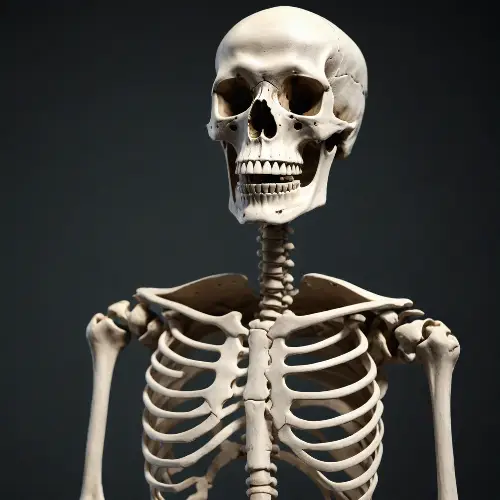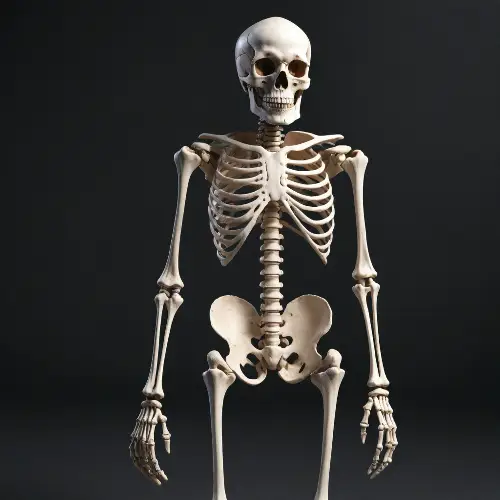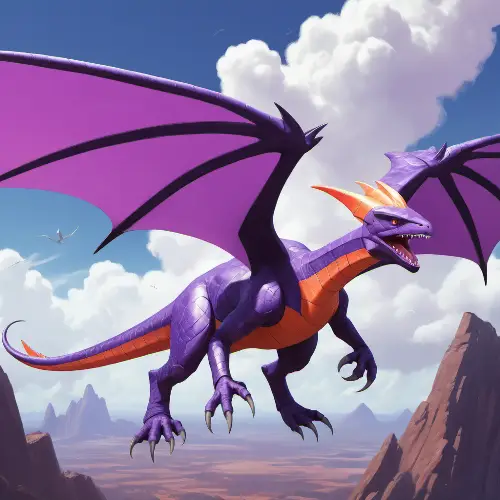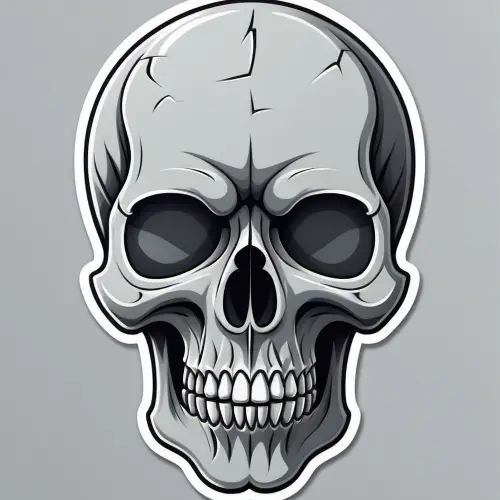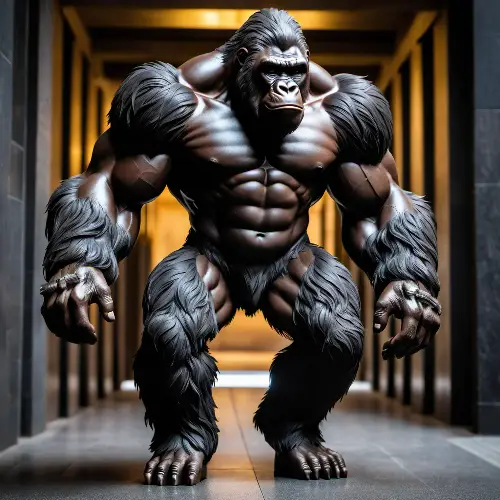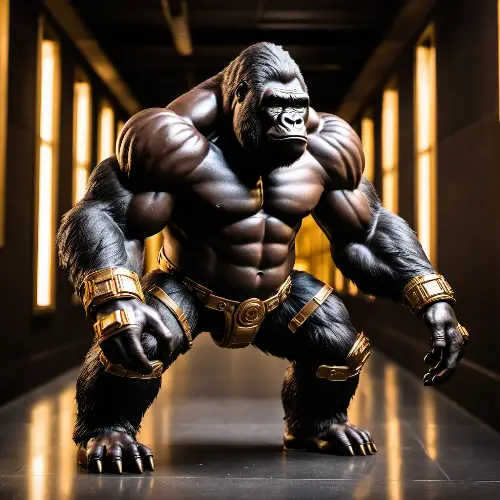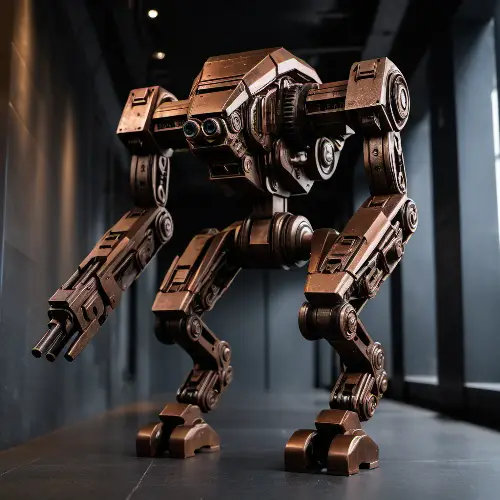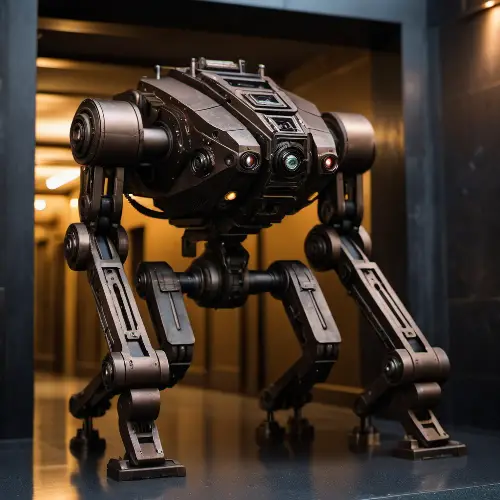a skeletal display prehistoric bird, positioned in an indoor setting that resembles a storage or workshop area for paleontological artifacts. The skeleton is prominently displayed in the foreground with a large, elongated skull that has a full set of pointed teeth, suggesting it could be a carnivorous species. The rest of the skeleton includes a vertebral column, ribcage, and long, slender legs, indicating that the creature was likely bipedal. The bones have a well-preserved appearance, with a texture that gives them an aged and fossilized look. In the background, there are shelves filled with various objects and artifacts that appear to be other bones or fossils, as well as tools and equipment that might be used for preparing and assembling skeletal displays like this one.
More Like This
a skeletal display prehistoric bird, positioned in an indoor setting that resembles a storage or workshop area for paleontological artifacts. The skeleton is prominently displayed in the foreground with a large, elongated skull that has a full set of pointed teeth, suggesting it could be a carnivorous species. The rest of the skeleton includes a vertebral column, ribcage, and long, slender legs, indicating that the creature was likely bipedal. The bones have a well-preserved appearance, with a texture that gives them an aged and fossilized look. In the background, there are shelves filled with various objects and artifacts that appear to be other bones or fossils, as well as tools and equipment that might be used for preparing and assembling skeletal displays like this one.
a skeletal display prehistoric bird, positioned in an indoor setting that resembles a storage or workshop area for paleontological artifacts. The skeleton is prominently displayed in the foreground with a large, elongated skull that has a full set of pointed teeth, suggesting it could be a carnivorous species. The rest of the skeleton includes a vertebral column, ribcage, and long, slender legs, indicating that the creature was likely bipedal. The bones have a well-preserved appearance, with a texture that gives them an aged and fossilized look. In the background, there are shelves filled with various objects and artifacts that appear to be other bones or fossils, as well as tools and equipment that might be used for preparing and assembling skeletal displays like this one.
a skeletal display, possibly a dinosaur or prehistoric bird, positioned in an indoor setting that resembles a storage or workshop area for paleontological artifacts. The skeleton is prominently displayed in the foreground with a large, elongated skull that has a full set of pointed teeth, suggesting it could be a carnivorous species. The rest of the skeleton includes a vertebral column, ribcage, and long, slender legs, indicating that the creature was likely bipedal. The bones have a well-preserved appearance, with a texture that gives them an aged and fossilized look. In the background, there are shelves filled with various objects and artifacts that appear to be other bones or fossils, as well as tools and equipment that might be used for preparing and assembling skeletal displays like this one. The workspace has a cluttered, yet organized look, with items like a blue stool and a workbench indicating ongoing work or study in this field.
a group of people in a dessert setting observing the realistic skeleton of a large, dragon-like creature. The creature's skeleton is the centerpiece, mounted on a platform that simulates a natural environment with a rocky and sandy surface. The skeleton is notable for its large size, elongated body, prominent ribcage, and a long tail that tapers to a point. It has four limb skeletons, indicating that the creature was quadrupedal. The skull of the creature is particularly striking, with an array of menacing, sharp teeth and pointed structures around its head, which could suggest horns or frills. The museum visitors are dressed in casual clothing, and their attention is focused on the impressive skeletal display, indicative of interest and curiosity. The lighting in the scene is soft, casting gentle shadows and giving the space a calm ambiance.
a large,realistic skeletal structure of a fantastical creature, reminiscent of a dragon, which appears to be part of an exhibit or a staged installation. The skeleton is quite elaborate with an extensive spine that tapers to a pointed tail. The creature's rib cage is expansive, and its wings are outstretched, with each wing bone dramatically long and thin. The skull of the creature is prominent in the foreground, with horn-like protrusions and an open jaw with sharp teeth visible. In the background, there are several people, suggesting that this might be a public display, possibly an outdoor exhibition or theme park attraction. The people are dressed in casual attire and appear to be observers or visitors, with some looking towards the skeleton and others engaged in conversation. The setting is overcast with a hint of hills in the distance, and the ground appears to be earthen and dug around the installation, enhancing the impression that this is a life-size representation of a mythical creature's remains.
a close-up of what appears to be a large fossilized claw, partially embedded in the earth. The claw is dark brown and exhibits a glossy sheen, with natural color gradations and textures that suggest mineralization over time. It's segmented, with prominent joints that indicate flexibility and movement, typical of a predatory creature. The surrounding soil is compact and earthy, with various shades of brown that suggest a dig site where such a fossil might be unearthed. Other fragments and pieces of fossils can be seen in the background, but they are not as clearly defined as the claw in the foreground. The size and preservation of the claw imply it could belong to a large prehistoric animal, such as a dinosaur, and would be of significant interest in the field of paleontology. The image captures the intricate details and the impressive scale of the fossil, providing a glimpse into the past and the creatures that once roamed the earth.
A meticulously crafted, wooden T-Rex skeleton model, assembled from interlocking puzzle pieces. The skeleton stands in a dynamic, lifelike pose, showcasing sharp teeth, a powerful tail, and robust legs. Its ribs and spine are intricately detailed, reflecting accurate paleontological design. The wooden texture is smooth, with a natural grain, and the pieces fit seamlessly together, creating a cohesive and sturdy structure. The model is set against a neutral background, emphasizing its detailed craftsmanship and the complexity of its assembly. The lighting is soft and even, highlighting the wooden texture and the precision of each joint and bone.
The image you’ve shared appears to depict a dragon skeleton. Here are some details: The skeleton is embedded in a surface that resembles rock or hardened clay. The dragon has a long, slender body with a distinct spinal structure and ribcage. There are two sets of limbs visible, which could be interpreted as arms and legs. The wings are large and bat-like, with visible bones supporting the wing membranes. The head is elongated with sharp teeth visible in the jaw, giving it a fierce appearance.
a group of people standing in a desert environment, looking at the impressive realistic skeleton of a large, mythical dragon-like creature. The creature is centrally positioned and dominates the scene with its massive skeletal structure. Its elongated body stretches across the sandy terrain, with a pronounced rib cage and a tail that extends far into the background. The dragon's head is characterized by a fierce-looking skull, complete with an array of sharp teeth and intricate cranial features that may suggest horns or decorative crests. The desert setting is sandy with a few rocks scattered around, and the color palette is dominated by earthy tones, which suggests a natural, outdoor locale rather than an indoor museum. The people observing the skeleton are wearing outdoor clothing suitable for a desert trek, and their attention is captivated by the skeletal remains, which appear to be a significant discovery in this arid landscape. The overall atmosphere of the image is one of wonder and exploration in a vast, open space under a bright sky.
a close-up view of what appears to be a fossilized skull partially embedded in soil. The skull has a distinctive, elongated shape with a jawline that is prominent and filled with sharp teeth, which are well-defined and vary in size. The eye sockets are deep and situated above the snout, which tapers to a point. There are also numerous pointed protrusions or spikes along the top and back of the skull, adding to its ferocious appearance. The texture of the skull suggests age and fossilization, with cracks and a rough surface. The background is composed of earthy tones, highlighting the skull and suggesting an archaeological or paleontological excavation site.
a close-up of what appears to be a realistic large fossilized claw, partially embedded in the earth. The claw is dark brown and exhibits a glossy sheen, with natural color gradations and textures that suggest mineralization over time. It's segmented, with prominent joints that indicate flexibility and movement, typical of a predatory creature.
a close-up of what appears to be a realistic large fossilized claw, partially embedded in the earth. The claw is dark brown and exhibits a glossy sheen, with natural color gradations and textures that suggest mineralization over time. It's segmented, with prominent joints that indicate flexibility and movement, typical of a predatory creature.
a large bone, likely from an animal, resting on a surface with a marble-like appearance. The bone is predominantly off-white with variations in color, including darker areas that suggest natural staining or perhaps age-related discoloration. The texture of the bone is rough with visible pores and lines that give it a realistic and organic look. One end of the bone is broader and shows signs of wear or perhaps the natural contours of the joint it once formed. The other end narrows slightly and seems to be cut or broken cleanly. The overall shape and size suggest it could be a femur or a similar large bone from a sizeable mammal. The surface on which the bone rests has a patterned design, with swirls of grey and white, resembling a polished stone or a marble tabletop.
a large bone, likely from an animal, resting on a surface with a marble-like appearance. The bone is predominantly off-white with variations in color, including darker areas that suggest natural staining or perhaps age-related discoloration. The texture of the bone is rough with visible pores and lines that give it a realistic and organic look. One end of the bone is broader and shows signs of wear or perhaps the natural contours of the joint it once formed. The other end narrows slightly and seems to be cut or broken cleanly. The overall shape and size suggest it could be a femur or a similar large bone from a sizeable mammal. The surface on which the bone rests has a patterned design, with swirls of grey and white, resembling a polished stone or a marble tabletop.
a close-up of a pale, textured surface that appears to be abone with a distinct marking that resembles a footprint. The imprint has three elongated toe-like depressions with pointed ends, which could be indicative of a track left by a bird or a small dinosaur. The surface around the imprint is rough and speckled with darker spots, suggesting age or weathering, and it has a slightly irregular shape, contributing to its natural appearance. The lighting is focused on the imprint, casting shadows within the depressions and emphasizing the contours of the mark, which adds depth and makes the footprint stand out against the lighter background of the material. The overall impression is that of a fossilized footprint or a natural impression captured in the surface, which could be of significant interest in paleontological studies.
a close-up of a pale, textured surface that appears to be abone with a distinct marking that resembles a footprint. The imprint has three elongated toe-like depressions with pointed ends, which could be indicative of a track left by a bird or a small dinosaur. The surface around the imprint is rough and speckled with darker spots, suggesting age or weathering, and it has a slightly irregular shape, contributing to its natural appearance. The lighting is focused on the imprint, casting shadows within the depressions and emphasizing the contours of the mark, which adds depth and makes the footprint stand out against the lighter background of the material. The overall impression is that of a fossilized footprint or a natural impression captured in the surface, which could be of significant interest in paleontological studies.
Title: Classic Majesty of Aerodactyl in Pokémon Lore Recommended aspect ratio: 16:9 Prompt: (Masterpiece artwork, official art style, high resolution: 1.2), this striking illustration masterfully resurrects the iconic Aerodactyl from the classic generation of Pokémon, capturing its prehistoric grandeur and aerial prowess, (a formidable body with leathery wings outstretched as if ready to take flight through epochs: 1.1), adorned with sharp, menacing teeth and a fierce expression that speaks to its ancient predatory instincts: 1.1), its armored scales patterned like earthy fossils, hinting at its storied past and resilience through time: 1.1), depicted soaring over a Jurassic landscape or perched on a rocky cliffside, surrounded by billowing clouds and the distant roar of thunder (prehistoric and atmospheric effects: 1.2), set against a backdrop of towering mesas and primordial forests under a sky streaked with hues of orange and purple twilight, showcasing bold, dynamic colors that evoke the raw power and untamed spirit of its ancient era, while gazing down upon the viewer with an unyielding gaze that encapsulates the essence of its ferocity and dominance in the skies.
a close-up view of what appears to be a dragon fossilized skull partially embedded in soil. The dragon skull has a distinctive, elongated shape with a jawline that is prominent and filled with sharp teeth, which are well-defined and vary in size. The eye sockets are deep and situated above the snout, which tapers to a point. There are also numerous pointed protrusions or spikes along the top and back of the skull, adding to its ferocious appearance. The texture of the skull suggests age and fossilization, with cracks and a rough surface. The background is composed of earthy tones, highlighting the skull and suggesting an archaeological or paleontological excavation site.
A gorilla shaped, large, chunky, mechanical creature with four legs lunging with weapons at the end of its upper limbs. Made of a dark bronze patina. Walking down a black stone corridor. Highly detailed, intricate. In frame. Creepy, intimidating, scary. Sci-fi. Large block of metal instead of hands.
A non-humanoid, large, chunky, mechanical creature with four legs lunging with weapons at the end of its upper limbs. Made of a dark bronze patina. Walking down a black stone corridor. Highly detailed, intricate. In frame. Creepy, intimidating, scary. Sci-fi. Large block of metal instead of hands.
a young man with curly red hair and a neatly groomed red beard. He is wearing round glasses with a thin frame, through which his blue eyes are looking directly at the camera, giving a sense of engagement with the viewer. His expression is neutral, with a closed mouth and a calm demeanor. He is dressed in a casual plaid shirt with a collar, suggesting a relaxed, perhaps academic setting. Behind him, there are shelves with various objects that resemble skulls and skeletal parts, which could indicate that he is in a laboratory, classroom, or a place of study related to biology or anthropology. The lighting is soft and diffused, providing a clear view of his features without harsh shadows. The background is out of focus
It was almost like someone tried to make an Asiatic dragon, long and sinuous without any way of keeping itself aloft to underline its magical nature, but they only knew about what it should look like secondhand. It was snakelike, but its scales were elongated, not like a snakes, or like the Entitys, but like a thousand canine teeth studding its form.Its head was snake-like in shape, but it didnt have a mouth, just a sucking hole at the front of its muzzle, lined with backwards-reaching tendrils. Down its body ran pair after pair of tiny, T-Rex arms, with long, eagle-like talons at the end of every digit. In two rows down its back were white bone spurs, the tops of which almost seemed ragged, but something glinted just above them, in a way that not even Quinns creations could detect. An enormous cluster of those spines bunched up around its tail, the air practically shimmering behind it.








































